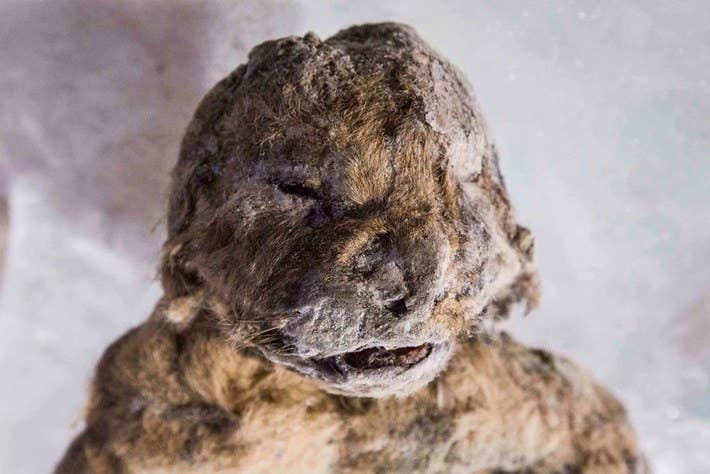37,000-year-old saber-toothed cub found frozen in Russian tundra
A frozen saber-toothed cub, preserved for 37,000 years, was discovered in Siberia, shedding light on the ecology of the Late Pleistocene.

Scientists uncover a mummified saber-toothed cub in Siberia. (CREDIT: Vera Salnitskaya/Siberian Times)
In 2020, researchers in Russia uncovered a mummified carnivore cub frozen in the Siberian permafrost for nearly 37,000 years. The discovery, made near the Badyarikha River in the Republic of Sakha (Yakutia), provides remarkable insights into a bygone epoch.
This rare specimen is part of the Late Pleistocene period, a time when mammoths, saber-toothed cats, and other megafauna roamed the Earth.
Radiocarbon dating places the cub between 35,471 and 37,019 years ago, a period when glaciers and vast tundra dominated the landscape. The Badyarikha region, known for its abundance of fossilized remains, has yielded many such treasures over the past decade. However, frozen mummified remains, like this one, are exceptionally rare.
The cub, estimated to be three weeks old at the time of death, belongs to the species Homotherium latidens, a saber-toothed predator. These formidable cats, often referred to as saber-toothed "tigers," were known for their massive, razor-sharp canines. Their specialized teeth allowed them to deliver fatal wounds to their prey, likely targeting the throat or abdomen.
Preserved in a block of ice, the Badyarikha cub's remains include its head and upper torso. The forelimbs are nearly intact, with well-preserved foot pads and claws.
Remarkably, the cub’s claws remain sharp and strongly curved, indicative of a powerful predator. The body is covered in short, dense, dark brown fur, ranging from 20 to 30 millimeters in length. This thick coat likely helped the animal survive in its frigid environment.
Anatomical analysis revealed unique adaptations for cold climates. Compared to modern lion cubs, the saber-toothed kitten displayed notable differences. Its muzzle was unusually shaped, featuring a wide mouth opening and smaller ears.
The neck was robust, while the forelimbs appeared elongated, suggesting adaptations for hunting in icy terrains. These characteristics differentiate Homotherium from any living feline species.
Related Stories
The research team used cutting-edge technology to study the specimen. A 3D model of the cub’s skull and teeth was created using computed tomography (CT) scans. Comparative analysis involved juvenile lion skulls and a modern lion cub carcass.
This comprehensive study, published in Nature Scientific Reports, allowed scientists to pinpoint subtle morphological distinctions between extinct and extant species.
Dr. Pavel Kosintsev, one of the lead researchers, emphasized the significance of this find. “For the first time in paleontology, we’ve studied the appearance of an extinct mammal with no modern analogs,” he said. The preservation of the cub’s soft tissues offers a rare glimpse into the anatomy and physiology of a long-extinct predator.
This discovery adds to the growing body of evidence about the diversity of life during the Pleistocene epoch. Fossils of Homotherium have been found across Eurasia, Africa, and the Americas, but this is among the few mummified specimens ever recovered. The cub’s discovery in Siberia expands our understanding of the species’ geographical range and ecological adaptations.
The Indigirka River basin, where the Badyarikha River flows, has been a hotspot for fossil discoveries. Over the past decade, scientists have unearthed mummies of various Late Pleistocene mammals, including mammoths and woolly rhinos. These findings collectively paint a vivid picture of an ecosystem teeming with large mammals adapted to harsh, cold environments.
Despite the wealth of information gleaned from the cub, questions remain about its life and death. The cause of death is still unknown. However, its pristine state suggests it was quickly buried in ice, preventing decomposition. The cub’s physical condition indicates it was well-fed and healthy, underscoring its species’ resilience in a challenging climate.
The study of this specimen is ongoing, with future publications expected to delve deeper into its anatomical features. The initial findings already provide valuable insights into the evolution and adaptation of saber-toothed cats.
As more specimens emerge from Siberia’s melting permafrost, scientists anticipate uncovering further details about the Late Pleistocene's rich biodiversity.
The Badyarikha mummy exemplifies the importance of paleontological research in understanding extinct species. Each discovery not only enriches our knowledge of ancient life but also helps contextualize the evolutionary pathways that led to present-day biodiversity.
For now, this frozen cub remains a testament to the wonders of a lost world, preserved in ice for millennia.
Note: Materials provided above by The Brighter Side of News. Content may be edited for style and length.
Like these kind of feel good stories? Get The Brighter Side of News' newsletter.
Rebecca Shavit
Science & Technology Journalist | Innovation Storyteller
Based in Los Angeles, Rebecca Shavit is a dedicated science and technology journalist who writes for The Brighter Side of News, an online publication committed to highlighting positive and transformative stories from around the world. With a passion for uncovering groundbreaking discoveries and innovations, she brings to light the scientific advancements shaping a better future. Her reporting spans a wide range of topics, from cutting-edge medical breakthroughs and artificial intelligence to green technology and space exploration. With a keen ability to translate complex concepts into engaging and accessible stories, she makes science and innovation relatable to a broad audience.



